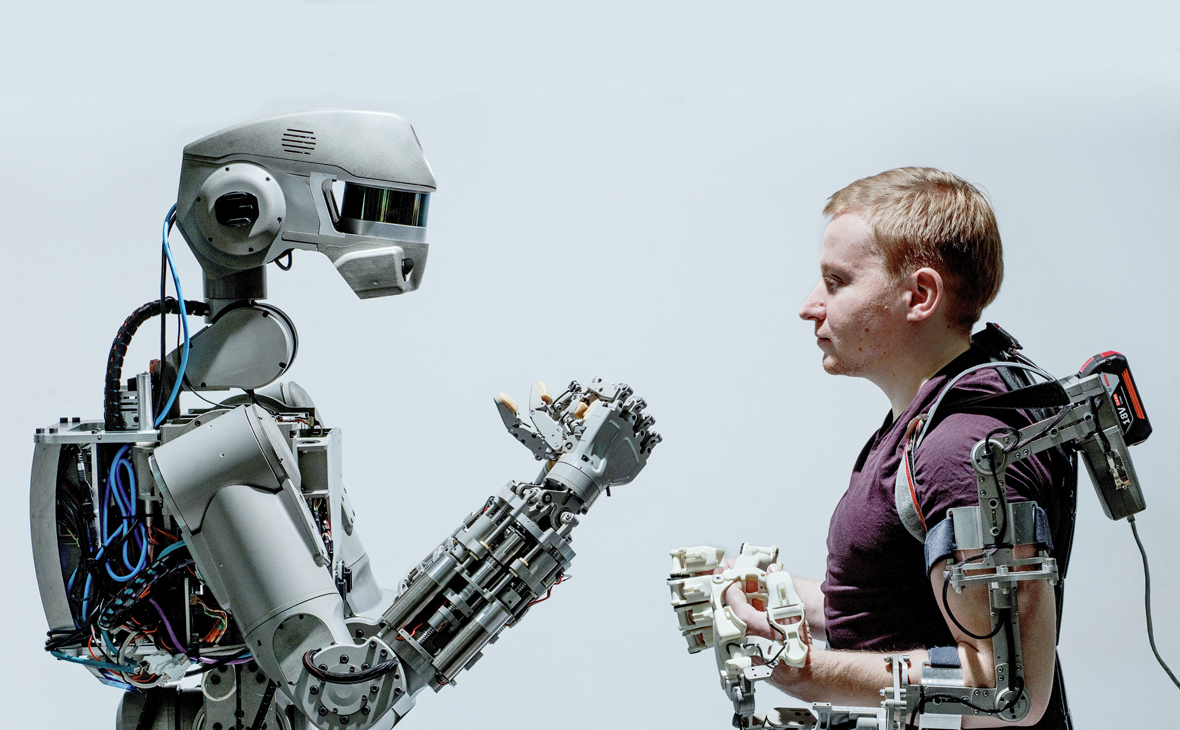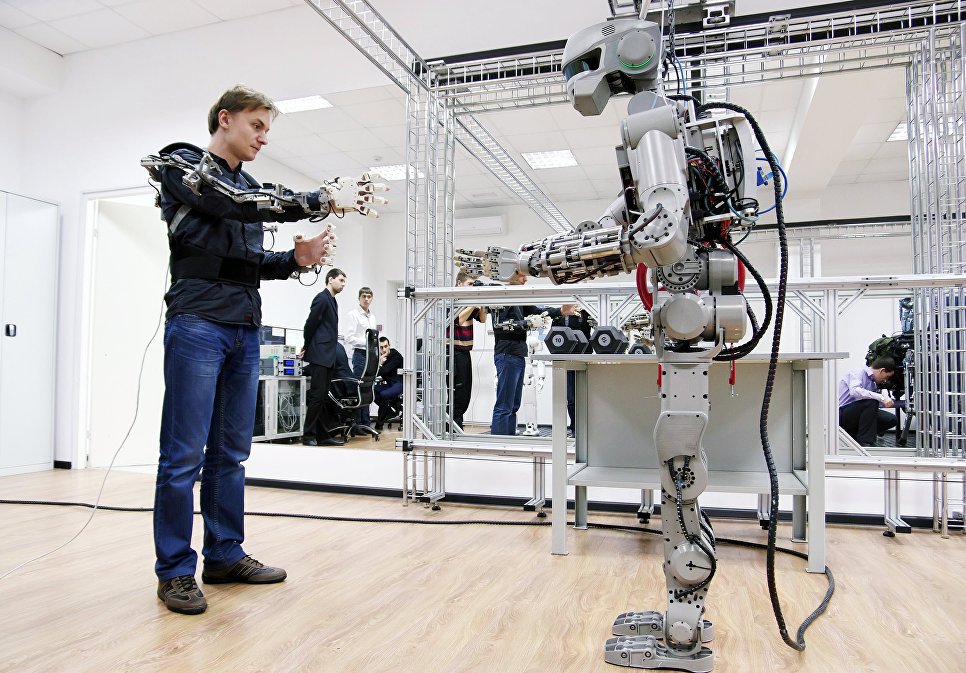FEDOR robot - training with the new crew of the ISS and the first space tasks

The crew, departing for the ISS on July 20, 2019, underwent training sessions with the FEDOR robot at the Cosmonaut Training Center (CPC).
In continuation of these publications:
The hatch of the Soyuz MS-14 spaceship turned out to be narrow for the FEDOR robot
How to finalize the FEDOR robot and the flight chair for the ISS
')
Crews are now rotated on the ISS, this week they returned to Earth from the ISS: Russian cosmonaut Oleg Kononenko, Canadian David Saint-Jacques and American Ann McClain.
Now there are left at the station: Alexey Ovchinin (Russia), Tyler Nicholas Haig and Kristina Koch (both from the USA).

On July 20, 2019, it is planned to send a crew of: Alexander Skvortsov, Andrew Morgan and Luka Parmitano to the ISS on the Soyuz MS-13 spacecraft.
Thus, two Russian cosmonauts, Alexander Skvortsov and Alexey Ovchinin, will work with the FEDOR robot on the ISS, and their foreign colleagues will help them.

The first training familiarization sessions with the FEDOR robot control system, including the study of methods of its operation in zero gravity, have already taken place in Star City.
Based on the results of these training events, comments on some elements of the FEDOR robot appeared in the new crew of the ISS, which will be eliminated by the developers and engineers of Roskosmos and RSC Energia before the flight.

“We had classes with him, this task appeared very unexpectedly, we had to solve it immediately. There are some remarks on the preparation, but these are remarks that astronauts who know what weightlessness understand. These are some nuances, I am sure that they will be eliminated and I hope that the result of working with FEDOR will be positive and interesting, and the first pancake will not be lumpy. You will see this in our surveys , ”said cosmonaut Alexander Skvortsov, without specifying the nature of the comments.
The FEDOR robot on the ISS will be operated in the "avatar" mode. Now cosmonaut Alexander Skvortsov is just training and being trained to study the use of the robot, learning to control his movements with the help of a special suit that captures the movements of a person and transmits them to the sensors of the robot.
“It turns out that it is in such a mode as an avatar,” said Alexander Skvortsov, answering the question of whether FEDOR will be the first android mechanism at the station.
“He (FEDOR) is efficient, but we keep a little intriguing. The tasks that he faced, decreased, there will be not much time. I will not voice the tasks - what I will do, and he will do it with me. It's interesting, you will see everything, ”intrigued Alexander Skvortsov.

It turns out that a space has already been prepared for the FEDOR robot on the ISS, so its deployment to the station and commissioning will not take long.
After docking, it will be transferred from the ship to the Russian segment of the station.
The power supply of the FEDOR robot during the flight inside the Soyuz spacecraft and on the ISS will be carried out from external rechargeable batteries, and not through the cables from the electrical systems of the spacecraft and the station.
In turn, the head of the Cosmonauts Training Center (CPC), Pavel Vlasov, confirmed that the main experiments with the FEDOR robot will be carried out by the crew going to the ISS on July 20, 2019, according to the working schedule.
“From the new one, what the crew will evaluate for the first time, and we will observe the possibility of functioning of the first serious robotic system as a FEDOR robot ,” said Pavel Vlasov, speaking about the tasks of the next expedition to the ISS.
The astronauts will evaluate in the conditions of the ISS the correctness of the design calculations when creating the FEDOR robot and the prospects for the implementation of this project to provide robotic support for the station crew with the prospect of long flights.
However, for the time being there is no talk of the FEDOR robot going into outer space , but the cosmonautics is interested in just this.
“We will eat the elephant in parts. First of all, it is created precisely as support for the crew in extravehicular activity. Moving along the station's surface at its present size from a football field is not easy and quick. Support may be elementary - transportation of some kind of tool, but there are quite a few possible applications , ”said Pavel Vlasov.
Now we are working on and adjusting the plan of tasks that the FEDOR robot will have to perform.
Previously, he had already been given the execution of twelve experiments, however, in the final program, most likely, they will include only four to six tasks that the FEDOR robot will repeat after man.
I wonder if there will be any tasks that, together with the Astrobee project’s robot-populations that already exist on the ISS , can be accomplished with FEDOR.
About the flight of the robot FEDOR
The two-day flight pattern will be applied when launching the Soyuz MS-14 spaceship with the FEDOR robot with the Soyuz-2.1a launch vehicle.
The launch of the Soyuz MS-14 transport spacecraft on the Soyuz 2.1a launch vehicle is scheduled for August 2019.
The flight of the ship will take place in unmanned mode, which will allow several times to increase the payload due to the lack of some of the instruments and components necessary for the crew to work.
Unmanned ship "Soyuz MS" - not a new modification of the manned spacecraft. This version of Soyuz MS is distinguished from a conventional serial ship by an upgraded motion and navigation control system (VDS) and the corresponding refinement of individual onboard systems.
During the flight, this system will be tested, as well as the integration of the Soyuz MS-14 spacecraft with the Soyuz-2.1a launch vehicle.
The carrier rocket "Soyuz-2.1a" will replace as a means of delivering people to the "Soyuz-FG" orbit with the Ukrainian control system. The stock of these missiles is almost exhausted.
Source: https://habr.com/ru/post/458014/
All Articles